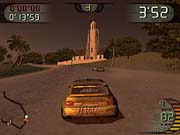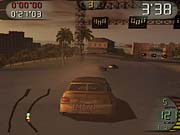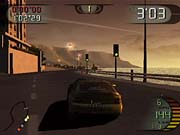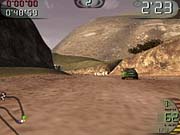GTC: Africa
Majesco and Rage offer a new twist on rally racing for the PlayStation 2.
Global Touring Challenge: Africa is a game that identifies itself as being a rally racing game, for lack of a better term. While you will indeed be racing off-road in various locations throughout the African continent, the types of cars you'll be driving aren't exactly the rally cars you're used to. In this way, GTC: Africa isn't a true rally racing game in the traditional sense--it's more of a twist on the existing concept of what a rally racing game should be. So far, the game's unique approach seems to be working out rather well.

GTC: Africa's concept is complemented by some unorthodox usage of nonrally cars, which keeps things engaging. Take the Pontiac Firebird or Ford Mustang, for example. When was the last time you saw either car racing on dirt, mud, or anything other than tarmac, aside from in late-night police video shows? Wouldn't both cars bottom out and take serious undercarriage damage on that first jump and ultimately be disqualified? Regardless, the Firebird and Mustang aren't the only odd vehicles you'll see on the tracks. Most of the cars in the game haven't been modified in any way to be used in a rally race. For the most part, you'll be using basic streetcars such as the Subaru Impreza, Ford Escort, and Mercury Cougar. None of these vehicles stand out as being the sorts of cars you'd expect to see in a rally race, and that's part of GTC: Africa's charm.

As we've already mentioned, the game takes place in Africa. There are roughly 19 different tracks to race on as you make your way through the game's main championship mode. The different locations for each race are anything but typical. In the first round of the championship, you'll start off by racing through a circuit of tracks that run along the East Coast. Each championship challenge is composed of 10 races on as many different tracks. These tracks offer a wide variety of terrain. As you progress, you'll see the difficulty of each race elevate as the terrain and your opponents get increasingly more difficult. The first race takes place in Cape Town, South Africa, on a straightforward track that is half tarmac and half dirt, but by the time you reach the sixth track, you'll be racing uphill and along ridges in the snow-covered mountains of Tanzania. Some of the tracks are wide open as you race through the arid geography of Tunisia or Morocco, while others are more constrained. Egypt has you racing through a seemingly endless lineup of 90-degree turns, and Kenya has you fighting for your place in line on a track that's often wide enough for only one car.
Before you enter the championship mode, you'll need to select a team to race for. There are a total of six teams to choose from, and each team can select four vehicles. Most of the teams use a few of the same cars, as there isn't a huge selection of vehicles in the game. Typically, the teams will have one lightweight car with strong acceleration or grip, a similar car with a better top speed, a middleweight car that balances the three, and a muscle car with great acceleration and top speed but very poor grip. Each car can be used quite well in the appropriate race, but if you go into a race like Egypt with the Firebird, you'll probably spend most of the time trying to maintain control of your car. Similarly, if you jump into a race with a number of straightaways driving a Ford Focus, you're likely to be left behind.

In addition to the championship mode, you'll find practice, single race, and challenge modes. Single race lets you race in any track you've unlocked through the championship mode. Practice lets you race on your own to get accustomed to the individual vehicles and the tracks. The challenge mode is entirely different from the other modes, with another 11 unique tracks. There are several different types of challenges to choose from, including speed pursuit, hill climbs, and timed catch-up races. Speed pursuit has you chasing after an opponent who starts out with a significant lead on you. Timed catch-up is similar to speed pursuit, with the only difference being that you are trying to overtake your opponent instead of using him as a gauge of your progress. Hill climbs are exactly as you might envision them, as you are racing almost entirely uphill, at lower speeds on winding tracks. There is also a downhill challenge, which has you taking the opposite approach.
The control is more arcade style than anything, and it fits the game perfectly. The cars do handle realistically for the most part, but the speeds you can reach with each car are for the most part unrealistic. On some tracks, you can get the lightweight cars, like the Mercury Cougar, up to about 180 miles per hour, which in reality is impossible, considering that you're often on dirt, sand, and mud. The feeling of speed is slightly skewed as well. When you're moving along at 40mph, it can feel like you're barely moving. Your vehicle's steering of is done with the left analog stick, with the X button for accelerating and the square button for braking. Triangle lets you look backward to see who's coming up on you, and the select button lets you switch between the three camera angles available: two chase cameras and a first-person mode. After each race, you can view a replay that flips through a variety of angles, including a helicopter camera complete with the muted sounds of the helicopter rotor.

The sound in the game is almost complete at this time, with a few things such as collision and tire sound effects missing. We expect that these will be added before the game's final release. The music is also pretty good, and it fits with the game's theme nicely. For the most part, it consists of African-themed trance music with tribal beats.
Graphically, GTC: Africa is pretty attractive. You won't see backgrounds composed of bitmaps anywhere in the game--all of the scenery is polygonal in nature. Even the tracks in the mountains have large 3D environments, and the draw-in distance is quite good overall. You'll always be able to see the lead car or the dust cloud it's kicking up in its wake, provided you have a clear view of their location. Many of the tracks have well-populated environments, replete with trees, fences, waterfalls, and buildings. There are also tracks that are pretty sparse, but that's simply due to the fact that this was the way they were designed. This mostly occurs on tracks where you're racing through the desert, where foliage and other highlights are in reality few and far between.
GTC: Africa is looking to bring something new to the table, with a different mix cars than you're used to seeing in rally racing games. The environments offer a nice mix of terrain, and the gameplay so far is pretty fun overall. Those interested in rally racing games will probably be interested in it if they're looking for a change from the norm. No release date has been set as of this writing, but judging by the level of polish on this build, it shouldn't be too far off. As always, you can check back with us at that time for a full review when the game is released for the PlayStation 2 in April.
Got a news tip or want to contact us directly? Email news@gamespot.com
Join the conversation